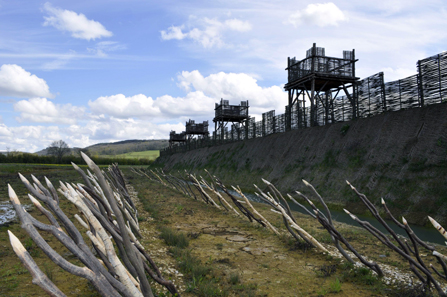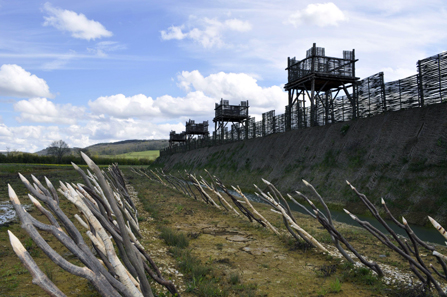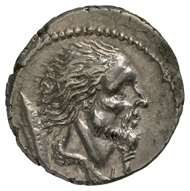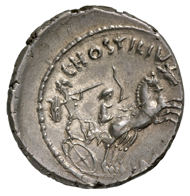Human Faces Part 10: In the Face of the Enemy
with the kind permission of the MoneyMuseum, Zurich.
Why is it that for centuries – or rather thousands of years – the head has served as the motif for the side of a coin? And why has this changed in the last 200 years? This chapter of the series ‘Human Faces’ looks at Caesar’s conquest of Gaul.
At the end of his consulship in the year 59 BC and seeking a new sphere of activity, C. Julius Caesar was appointed three provinces. Each was carefully selected with a single consideration in mind: It had to offer sufficient conflict potential in order to justify a war. After all, Caesar lived at a time when political power could only be achieved through conquests. And power in Rome was what Caesar wanted.
Reconstruction of the siege fortifications that Caesar ordered constructed around Alesia, site of the Gallic resistance. Photo: Prosopee. http://creativecommons.org/licenses/by-sa/3.0/deed.en
As it so happens, the conflict actually broke out in a region that was remotely connected to one of his provinces, Gallia Narbonensis (i.e., Southern France). The Helvetii wanted to move from their country, which did not offer them enough in the way of sustenance, to another region. Their route led them through Narbonensis. This offered Caesar the occasion, and he provoked a war that within a few years would adversely affect all the inhabitants of Gaul. Like a domino effect, one conflict triggered the next. Most Celtic tribe leaders reacted helplessly, attempting in vain to solve the problem on their own. It wasn’t until the year 52 BC that Vercingetorix succeeded in gathering the tribes of central Gaul and mobilizing them into concerted action. The end result of his efforts is well known: During the siege of Alesia, he sacrificed himself for the sake of his fellow combatants, and surrendered to Caesar to at least spare the others’ lives. The Roman commander kept him imprisoned for six years before parading him around at his triumphal procession in 46 BC, after which he had him put to death.
It’s believed that 1.2 million Celts were killed during the conquest of Gaul. That’s 1.2 million people sacrificed solely for the political goals of one man. Did it all pay off for Caesar at least?
Roman Republic. Denarius, minted under the watch of mint master L. Hostilius Saserna, 48 BC. Head of a Gaul facing right, and behind it, a Gallic shield. Rev., Celtic chariot in pursuit, facing right, with Celtic warrior in full armament on the chassis. © MoneyMuseum, Zurich.
He had hoped that through his victories, he would be afforded so much political respect in Rome that he would continue to play a decisive role in politics in the future. But even the senators, who themselves were certainly none too prim or lenient, were suspicious of Caesar’s methods. They planned to bring charges against him. At the beginning of 49 BC, it came to a breaking off. Caesar crossed the Rubicon and set into motion a propaganda machine designed to show his merits in the proper light. This, of course, included the conquest of Gaul, depicted quite plainly as a reminder to the city’s inhabitants on coins, the one featured here being just one example.
On the 9th of August 48 BC, the year in which our piece was likely minted, Caesar defeated the Senate’s army and made himself the de facto sole ruler of the Roman Empire.
In the next chapter, you’ll learn how Caesar depicted himself on the coins following his Civil War victory.
All sections of the series can be found here.
The book ‘MenschenGesichter’ is available in printed form from the Conzett Verlag website. It soon will be translated to English. …










